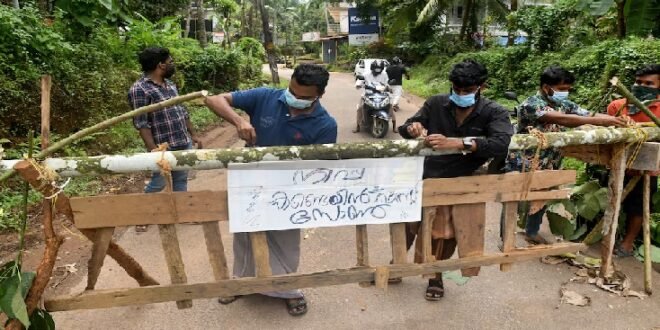28-07-2025
Bureau Report + Agencies
NEW DELHI/ PALAKKAD: On July 12, a new deadly Nipah virus infection was confirmed in a 52-year-old man in the Palakkad district of Kerala, marking the tenth instance of Nipah virus spillover (transmission of the pathogen from animals to humans) in the southern Indian state since 2018.
 This year alone, Kerala has reported four Nipah cases, including two deaths, all within a 50km (30-mile) radius, on the border of the Malappuram and Palakkad districts.
This year alone, Kerala has reported four Nipah cases, including two deaths, all within a 50km (30-mile) radius, on the border of the Malappuram and Palakkad districts.
The state remains on high alert, with 675 people under surveillance across five districts.
Here is what we know about the Nipah virus, its symptoms and how authorities are containing it.
What is the Nipah virus?
Nipah virus (NiV) is a highly pathogenic zoonotic virus (a virus that can be transmitted from animals to humans) which causes death in 40 to 75 percent of human infected cases. Alongside the Hendra virus, which is found in Australia, NiV is one of the most notable viruses from the henipavirus genus of the paramyxovirus family, responsible for a range of neurological often respiratory, diseases in humans and animals.
Fruit bats of the Pteropodidae family, ubiquitous across Oceania, South and Southeast Asia, and sub-Saharan Africa, are natural reservoirs of the virus, meaning the virus naturally lives and reproduces in these mammals without causing them any harm.
The spillover of the virus to humans can happen directly or via intermediate hosts such as pigs or horses, which come into contact with humans.
What are the symptoms of the Nipah virus?
According to the World Health Organization (WHO), human NiV infections range from asymptomatic infection to acute respiratory infection, seizures and fatal encephalitis (inflammation of the brain).
 The clinical presentation of NiV infection is neurological, affecting the central nervous system and resulting in acute encephalitis syndrome (AES), characterized by seizures, confusion and loss of consciousness. When the disease advances, it can cause damage to the lungs and can lead to life-threatening acute respiratory distress syndrome (ARDS).
The clinical presentation of NiV infection is neurological, affecting the central nervous system and resulting in acute encephalitis syndrome (AES), characterized by seizures, confusion and loss of consciousness. When the disease advances, it can cause damage to the lungs and can lead to life-threatening acute respiratory distress syndrome (ARDS).
The incubation period of the virus is believed to be four to 14 days.
Where have there been Nipah virus outbreaks before?
The first human NiV infection was recorded in 1998, when pig farmers and butchers from Malaysia and Singapore contracted the virus from infected pigs. The outbreak affected more than 250 individuals and caused more than 100 deaths.
There have been subsequent, almost annual outbreaks in Bangladesh since 2001, with human infection traced to the consumption of date palm sap contaminated with urine or saliva from infected fruit bats.
In 2014, NiV infections in the Philippines were associated with the slaughter of horses and consumption of infected horse meat.
India has reported two outbreaks in West Bengal in 2001 and 2007. In 2018, South India reported its first NiV outbreak in Kerala, when 19 confirmed cases led to 17 deaths. Since then, Kerala has reported NiV spillovers almost every year.
What has happened in Kerala?
Although Kerala has recorded 10 instances of NiV spillover since 2018, only two of them turned into outbreaks with instances of human-to-human spread.
 Pressmediaofindia
Pressmediaofindia




